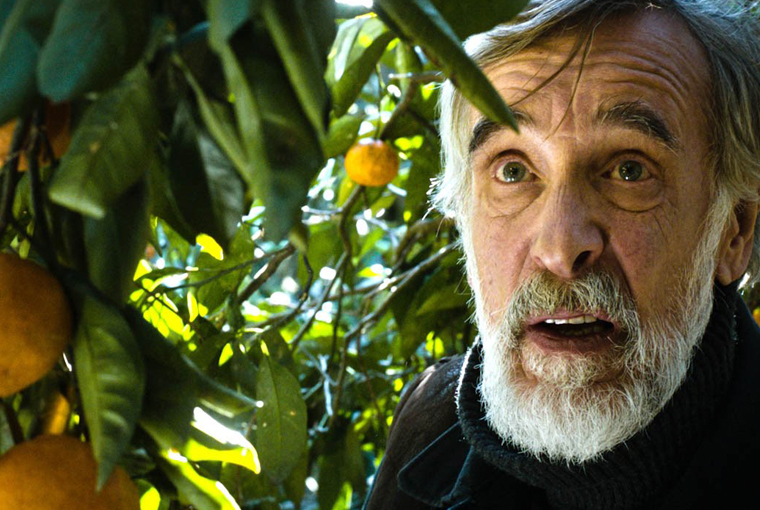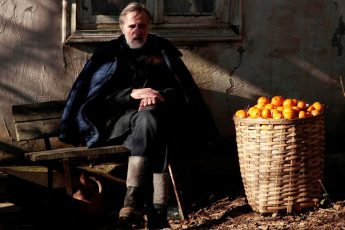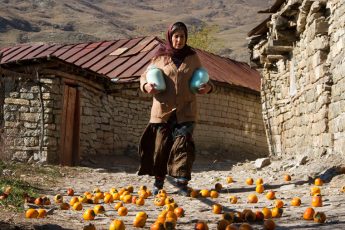
In 2015, we shift our regional focus to the cinemas of Armenia, Azerbaijan and Georgia – the three South Caucasian republics. After summing up the findings of our Polish year in our December editorial, we now offer you a sketch of film politics and recent developments in our main region of interest for this year.
We begin with Georgia, because Georgian filmmakers have been proving the loudest in the past few years. In spite of occasional successes – take the French-Georgian thriller Tzameti (2005) by Géla Babluani or Tinatin Gurchiani’s low-budget The Machine Which Makes Everything Disappear (2012) – the definitive breakthrough came with the Berlinale 2013, which starred two Georgian films, notably Nana Ekvtimishvili’s and Simon Groß’ palmy In Bloom. While this journal voiced its misgivings and warned of premature conclusions (some had already started speaking of a New Wave), the improvement in directorial quality that works like In Bloom marked is unquestionable: stylistically and visually mature, Georgian films have finally been able to provoke, and touch. Georgia was again represented by two films at 2014’s Berlinale, the year concluding with two films by Georgian directors shortlisted for the Foreign Language Oscar (Tangerines by Zaza Urushadze, which got nominated, and Corn Island by Giorgi Ovashvili). Georgia draws on a rich cinematic tradition which was nurtured even as contemporary directors were attracting little attention: in the late 1990s and 2000s, when Georgian cinema seemed close to death, otherwise violent, sensationalist and sometimes inhuman television stations disseminated Georgian classics on a daily basis. Psiqo by film historian and journalist Giorgi Gvakharia – a classic among intellectual TV shows – combined its weekly talks on culture, politics and society with related film showings (Pasolini, Loach, Polanski – you name it).
Georgia’s affinity for cinema is unquestionable, though its recent rise to fame also seems to be due to the nation’s diplomatic talents. The objective improvements of Georgian cinematic culture on both aesthetic and political levels were systematically exaggerated – it is hard to see why films like A Fold in My Blanket or Brides made the Berlinale selection either for artistic or political reasons. Just like former presidents Edvard Shevardnadze and Mikheil Saakashvili were able to gather ungrudging support for widely illegitimate regimes, Georgian cinema has been met with disproportionate enthusiasm. Tamara Tatishvili, former head of the Georgian National Film Center, was even decorated with an order by the French state for her contribution to the improvement of French-Georgian cultural relations.
In 2015, the Georgian National Film Center is planning to spend 2.5 million GEL – appr. 1.1 million EUR – on fiction film development alone (including support for co-productions). That constitutes a 24% increase in funds compared to 2014, a political decision clearly made possible by recent successes. The film center provides up to 75% of the budget of a film with funding decisions made by an official, Western-style committee. In addition to co-production grants, the state provides tax breaks and other incentives to boost foreign film production, though talent and resources are reportedly too scarce to provide ground for more than one major project to be shot at any given time. The region of Adjara in Western Georgia, which is under the control of Tbilisi but administratively largely autonomous, has set up its own funding program, if with a negligible budget.
Though there are just over ten cinema halls in Georgia, economic hardship and an unregulated online streaming/downloading culture make it difficult to expand. As a first step towards tackling this common problem, South Caucasian republics could try boosting film events – with the Tbilisi International Film Festival (December) and the Batumi International Art-house Film Festival (September), Georgia already has two major film events which attract a stable film community and promote regional cinema.
Looking south towards Armenia, Georgians’ enthusiasm over their contemporary cinema becomes more understandable. The National Cinema Center of Armenia had reserved 293 518 700 AMD (appr. 524 000 EUR) for feature film production in 2014, while the Georgian National Film Center spent 840 000 EUR that same year. The result is appropriate, as few films are produced, and even fewer make the international festival circuit. Lacking proper state support, Armenian filmmakers are forced to turn to private investors dependent and/or keen on making profit. Hence, a vast majority of films are light-hearted comedies and kitschy dramas devoid of artistic appeal which are for the most part unable to attract audiences outside of Armenia (a notable exception is the Armenian diaspora, which seeks out Armenian films and organizes series and showings abroad). Those films dealing with historical traumas like the Armenian genocide or the Nagorno-Karabakh War traditionally appeal to Armenians’ patriotic demands.
Clearly, the stark differences between Armenia and Georgia are in part structural, and by extension political. The overall stricter political atmosphere in both Armenia and Azerbaijan could be one reason why a lively film community that lives up to Georgian standards has not yet emerged – Georgia is far from being the democracy many in the West depict it as being, but nevertheless that much more democratic and open. If cinematic cultures do tend to emerge under oppressive regimes (e.g. Iran or Russia), smaller countries like Armenia and Azerbaijan have little space for the emergence of such sub-cultures. As long as state structures (which dictate the formation of cinema even in countries as prosperous as France or Germany) are permeated by retrograde officials while intellectuals flee the region, directors in Armenia and Azerabijan will struggle to produce films that address pressing problems. More spending in the cinema sector won’t necessarily relativize that problem. Whether Soviet anti-establishment films will prove an inspiration is yet to emerge. But the economic and political situation for Armenian and Azerbaijani filmmakers doesn’t exactly seem to have improved.
Azerbaijani cinema perhaps has the least known film culture of the three countries. It is quite telling that Azerbaijan gets by with a mere mention in an article entitled “Film in the Caucasus” in A Dictionary of Film Studies, whereas both Armenia and Georgia are presented as having developed a distinct film culture since their independence from the USSR. 20 years after the fall of the USSR, the most significant international success from Azerbaijan is still Burnt by the Sun (1994). The Russian film by Nikita Mikhalkov was co-written by Azeri author Rustam Imbrahimbeyov. However, the 110th anniversary of Azerbaijani cinema in 2008 prompted the late President Heydar Aliyev to sign a decree stating the necessity to invest more in the film industry. 2010 was the first time an Azerbaijani film, Sahe (The Precinct), was presented in the Cannes market. The oil-rich country is also heavily investing in infrastructure projects. However, while Azerbaijan still had 21 cinemas in 2005, today this number has halved. With a little over 200 000 visitors per year, Azerbaijan can hardly be called a nation of film buffs. Moreover, roughly 70 % of films that make it into one of the film theaters are foreign productions.
Today, the main financing source of film production in Azerbaijan are public resources which are not centralized. Even though there is an Azerbaijan Film Commission, funding can vary in the 74 administrative regions and can also come from state-owned companies. According to the Ministry of Culture, Azerbaijan spends about 7 million euros on cinema-related projects and plans to increase that amount in the future. Though that is considerably more than Armenian spending, Azerbaijani filmmakers will most likely still be forced to sign co-production contracts and look for funding abroad. While the festival hit Nabat (2013) was entirely produced by the local production company “Azerbaijan film”, it nevertheless featured Iranian actress Fatemah Motamed-Aria and an Iranian film crew. The lack of confidence young filmmakers have in the local production climate can also be seen by the large amount of directors who have studied abroad, like Ru Hasanov who studied in the states, Elmar Imanov who studied and lives in Germany, or Ilgar Safat who studied film in Moscow.
Located between Orient and Occident, Azerbaijan will certainly not exclusively look to Europe as a source for money and inspiration. A majority of the country has Muslim roots. It will be interesting to observe how this unique cultural background will influence films and filmmakers. Whether there is enough money and interest for productions which can reflect this culture as well as some of Azerbaijan’s specific political and social problems remains to be seen. The film Chameleon (2013) is particularly promising in this respect.
***
We launch our 2015 regional focus on the South Caucasus with an issue exclusively dedicated to recent films from the region. Julia Zelman saw Tangerines, in which two enemies fighting in the Abkhaz-Georgian war end up in a cottage where they are tended to and led towards reconciliation by a local Estonian villager. Similar convergences take place in Natalya Belyauskene’s If Only Everyone…, an Armenian film exploring the traces of the Nagorno-Karabakh War between Armenia and Azerbaijan. The war is also at the center of Nabat, an Azerbaijani production from 2015, in which it empties an entire mountain village, with only a lonely woman and her sick husband left behind. Moritz Pfeifer praises Chameleon for how it illustrates social and economical changes that emerged with the downfall of the Soviet Union. Finally, we looked at what German reviewers had to say about German-Turksish director Fatih Akin’s The Cut (2014), which addresses the Armenian genocide under the Ottoman Empire that took place in 1915.
Konstanty Kuzma & Moritz Pfeifer
Editors




Leave a Comment